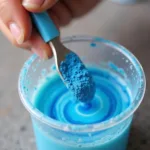Dyeing Easter eggs with gel food coloring is a fun and vibrant way to celebrate the spring season. This guide will walk you through the process of creating beautifully colored eggs using gel food coloring, offering tips and tricks for achieving stunning results. can you use gel food coloring to dye easter eggs Let’s dive into the world of vibrant Easter egg dyeing!
Preparing for Easter Egg Dyeing
Before you begin dyeing, gather your supplies. You’ll need hard-boiled eggs, white vinegar, gel food coloring, water, and containers for dyeing. Small bowls or cups work well. You might also want gloves to protect your hands from staining, and paper towels for cleanup.
The Magic of Gel Food Coloring: A Vibrant Choice
Why choose gel food coloring? Gel food coloring offers more intense and vibrant colors compared to liquid food coloring. A little goes a long way, making it a cost-effective choice. Plus, the concentrated formula means less water is needed, resulting in richer hues that adhere beautifully to the eggshells.
How to Dye Easter Eggs with Gel Food Coloring: A Step-by-Step Guide
-
Prepare the Dye Baths: In each container, mix about 1 cup of hot water with 1 tablespoon of white vinegar. Vinegar helps the color bind to the eggshells, resulting in a more even and vibrant dye job.
-
Add the Gel Food Coloring: Add a small amount of gel food coloring to each water-vinegar mixture. Start with a toothpick’s worth and add more until you achieve your desired color intensity. Remember, a little goes a long way!
-
Dye the Eggs: Gently submerge each hard-boiled egg into the dye bath. Ensure the egg is completely covered. Leave the eggs in the dye for several minutes, checking periodically until the desired color is achieved. The longer the egg soaks, the deeper the color will be. can you dye easter eggs with gel food coloring
-
Drying and Displaying: Remove the dyed eggs from the dye baths and place them on a paper towel-lined surface to dry. Once dry, arrange your beautifully colored Easter eggs in a basket or display them as part of your festive décor.
Creative Techniques for Unique Designs
- Marbling: Create marbled effects by adding a few drops of a different color gel food coloring to the dye bath after the initial dye. Swirl gently with a toothpick.
- Speckled Eggs: Flick small droplets of diluted food coloring onto the dyed eggs for a speckled look.
- Rubber Band Designs: Wrap rubber bands around the eggs before dyeing to create interesting patterns.
“Gel food coloring truly opens up a world of possibilities for Easter egg dyeing,” says renowned color specialist, Ava Carter. “The vibrant hues and ease of use make it a perfect choice for both beginners and experienced egg decorators.”
Troubleshooting Common Issues
- Uneven Color: Ensure your eggs are completely submerged in the dye bath. Adding more vinegar can also help with even color distribution.
- Pale Colors: Use more gel food coloring or let the eggs soak for a longer time. what food coloring makes purple how to make purple with food coloring
- Color Bleeding: Dry the eggs thoroughly after dyeing to prevent color transfer.
Conclusion
Dyeing Easter eggs with gel food coloring is a rewarding and enjoyable activity for all ages. With a few simple steps, you can create stunning, vibrant eggs that will brighten your Easter celebrations. how do you make the color brown with food coloring So gather your supplies and let your creativity flow!
FAQ
- Can I use regular food coloring instead of gel? Yes, but the colors may be less vibrant.
- How long should I boil the eggs before dyeing? Boil for about 10-12 minutes for easy peeling.
- Can I reuse the dye bath? It’s not recommended, as the color may fade.
- How do I clean up food coloring stains? Soap and water usually work well. A paste of baking soda and water can also be effective.
- How can I store dyed eggs? Refrigerate the dyed eggs in a covered container.
For any assistance, contact us at Phone Number: 0373298888, Email: [email protected] Or visit us at: 86 Cau Giay, Hanoi. We have a 24/7 customer service team.

